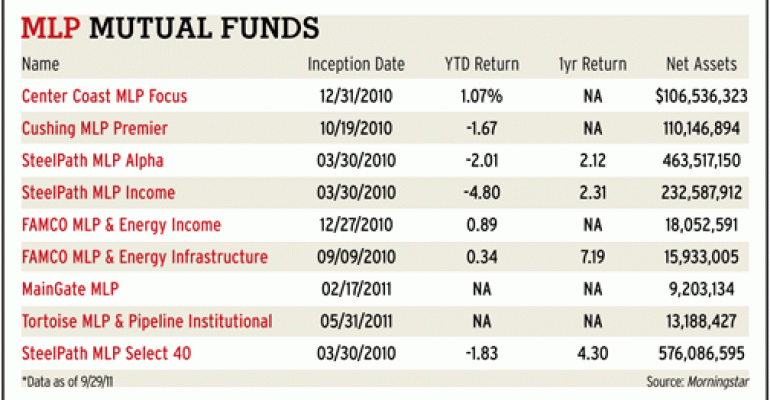In the current low interest rate environment, one that’s expected to last a while, yield is hard to come by. The yield on the 10-year Treasury is under 2 percent, while the yield on the five-year Treasury is under 1 percent. Meanwhile, the ebbs and flows of the stock market are causing retail investors to flee equities and domestic equity mutual funds. But master limited partnerships that don’t have commodity price exposure can provide one option for investors to achieve stable cash flows in a low interest rate environment, sources say.
“Slow growth, recessionary environment, low rates—that’s usually the perfect time for most higher yielding equities, but particularly so for MLPs just because they tend to maintain a growth profile better than other yielding equities,” says Brian Watson, director of research at SteelPath, a manager of MLP mutual funds.
These days, investors are more risk-conscious, and income-generating strategies have garnered broader investor interest, says Todd Rosenbluth, S&P Capital IQ fund analyst. MLPs are required to pay dividends to shareholders, and investors have been flocking to dividend-paying stocks in 2011, he says. MLPs’ peer group is energy stocks and energy stocks have performed well this year, with oil and gas storage and transportation companies up 9 percent year-to-date (through Sept. 29).
James Shelton, CIO of Houston-based wealth management firm Kanaly Trust, which invests in MLPs directly, said you can buy high-quality energy MLPs that yield 6 to 7 percent, with a total return expectation of 10 to 12 percent on an annual basis. “That’s a fairly stable cash flow stream to support those dividends.”
An MLP is a limited partnership (or sometimes an LLC choosing partnership taxation), that is traded on the public exchanges (i.e., NYSE, NASDAQ, Amex) just like corporate stock. A share in an MLP is called a “unit,” and its investors are “unitholders.”
The biggest difference between an MLP and a corporation is that as a partnership, the MLP does not pay corporate tax. This allows it to distribute more of its earnings to investors. A partnership is not considered to be a separate taxable entity but is treated as a “passthrough” entity comprised of all its partners. The partnership’s income is allocated for tax purposes among all the partners, who pay tax on their share.
In other words, a majority of the returns will be characterized as return of capital. But once you sell, a portion of that sale can be treated as capital gains and another portion can be treated as ordinary income, Shelton says. MLP investors receive no 1099s and instead get end-of-year K-1 forms, which are more complex and often unfamiliar to retail investors. However, MLPs are popping up in structures that make it easier to file taxes, such as mutual funds and ETFs, but they don’t have the same tax efficiencies as investing directly.
Investing in Pipelines
Some MLPs are very much exposed to cyclical forces, such as commodity prices, Shelton says. MLPs that invest in natural gas, liquids, coal and propane can be more exposed to changes in commodity prices. Pipeline MLPs, however, tend to hold up better in volatile times and are not as exposed to commodity prices, says Avi Feinberg, equity analyst at Morningstar. Shelton prefers the stability of pipeline networks, such as Enterprise Products or Plains All America Pipeline.
“As long as we have some growth or we’re not in a deep recession, those business models can remain fairly stable, if you will,” Shelton says. “So we can have a high degree of confidence in the durability of that cash flow stream to support the dividend.”
Jason Thomas, chief investment officer at Aspiriant, which uses MLPs in some client portfolios, says new discoveries of oil and natural gas are outside of the geography served by the existing pipeline infrastructure, which creates an opportunity for future growth. He also says pipelines are not subject to commodity prices, but are more of a volume business.
That said, it’s important to take a close look at a particular MLP’s exposure to commodity prices and the risks that can come with that sector. “They’re not all pipelines, so you have to be careful and do your homework and figure out what you’re really buying if you don’t want commodity price exposure,” Watson says.
MLP Mutual Funds
There are many different ways to invest in MLPs, including directly, through a fund of MLPs, closed-end funds, or through exchange traded products. Mutual funds that invest in MLPs have become a growing trend in the last two years, with SteelPath introducing the first MLP mutual funds in May 2010. The firm launched its MLP Alpha Fund (MLPAX), its MLP Income Fund (MLPDX) and MLP Select 40 Fund (MLPFX). There’s now at least $1.5 billion in mutual funds with “MLP” in their name, according to Morningstar data.
Rosenbluth says SteelPath’s MLP Select 40 Fund has held up well compared to its natural resources peer group. Year-to-date through Sept. 29, the fund is up 1.8 percent, compared to its peer group being down 16 percent.
The mutual fund structure can make it easier for retail investors to get exposure to MLPs, with low minimums, a 1099 tax filing and daily liquidity. But these funds don’t have a three-year track record, and you lose some of the tax benefits of investing in MLPs directly, Shelton says. Under the mutual fund structure, you lose that tax-deferred status.
Here is a list of some prominent MLP mutual funds, all launched since 2010:







